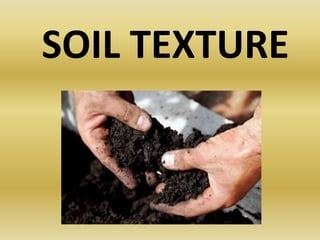Report
Share
Download to read offline

Recommended
Recommended
More Related Content
Similar to soiltexture-151011131546-lva1-app6891.pdf
Similar to soiltexture-151011131546-lva1-app6891.pdf (20)
Chapter 4 soil composition & engineering properties

Chapter 4 soil composition & engineering properties
Recently uploaded
Recently uploaded (20)
Discovery of an Accretion Streamer and a Slow Wide-angle Outflow around FUOri...

Discovery of an Accretion Streamer and a Slow Wide-angle Outflow around FUOri...
Vip profile Call Girls In Lonavala 9748763073 For Genuine Sex Service At Just...

Vip profile Call Girls In Lonavala 9748763073 For Genuine Sex Service At Just...
Biogenic Sulfur Gases as Biosignatures on Temperate Sub-Neptune Waterworlds

Biogenic Sulfur Gases as Biosignatures on Temperate Sub-Neptune Waterworlds
❤Jammu Kashmir Call Girls 8617697112 Personal Whatsapp Number 💦✅.

❤Jammu Kashmir Call Girls 8617697112 Personal Whatsapp Number 💦✅.
Labelling Requirements and Label Claims for Dietary Supplements and Recommend...

Labelling Requirements and Label Claims for Dietary Supplements and Recommend...
Forensic Biology & Its biological significance.pdf

Forensic Biology & Its biological significance.pdf
Formation of low mass protostars and their circumstellar disks

Formation of low mass protostars and their circumstellar disks
Pests of mustard_Identification_Management_Dr.UPR.pdf

Pests of mustard_Identification_Management_Dr.UPR.pdf
FAIRSpectra - Enabling the FAIRification of Spectroscopy and Spectrometry

FAIRSpectra - Enabling the FAIRification of Spectroscopy and Spectrometry
Connaught Place, Delhi Call girls :8448380779 Model Escorts | 100% verified

Connaught Place, Delhi Call girls :8448380779 Model Escorts | 100% verified
soiltexture-151011131546-lva1-app6891.pdf
- 1. SOIL TEXTURE
- 2. SOIL TEXTURE The look and the feel of a soil is referred as soil texture which is determined by the relative proportion of mineral particles of different sizes present in the soil. Soil are composed of sand ,slit and clay particles. Stones and gravels are excluded from the textural classes.
- 3. SIZE OF THE PARTICLES Particle size is determined by the diameter of individual soil fragments. According to the International system of soil classification ,size of different particle are as follows: Clay – less than 0.002 mm Slits – 0.002mm to 0.02mm Sand – 0.02mm to 2.0mm • very fine sand – 0.02mm to 0.10mm • Fine sand – 0.10mm to 0.25mm • Medium sand – 0.25mm to o.50mm • Coarse sand – 0.50mm to 1.0mm • Very coarse sand – 1.0mm to 2.0mm Gravel - larger than 2.0 mm
- 4. FIGURE SHOWING DIFFERENT SOIL PARTICLES
- 5. HOW THESE PARTICLES CAN BE SEPARATED • To separate the particle of different sizes ,the organic matter of soil is oxidized and inorganic cementation is removed to breakdown structural aggregation. • Fine fractions are removed from coarser material by sedimentation technique. • Coarse fraction is dried and graded by sieving.
- 6. • Stones and gravels are retained by 2.0 mm perforated plate sieve , the coarse sand retain on a 70 mesh wire sieve ( 0.23 mm per opening) while the fine sand passes through the 70 mesh. • Slit and clay fractions are graded according to sedimentation velocity in a liquid column.
- 7. TEXTURAL GROUPS • On the basis of proportion of different size particle ,soils are classified into different textural groups; TEXTURAL GROUPS RELATIVE PROPORTION OF DIFFERENT SIZED MINERAL PARTICLE Sandy soil 85% sand + 15%clay or slit or both Loamy sand 70% sand + 30% clay or slit or both Loam soil 50% sand +50% clay or slit or both slit 90% slit + 10% sand
- 8. TEXTURAL CLASSES OF SOILS SERIAL NUMBER SOIL CLASSES OR TEXTURAL NAMES RANGE IN RELATIVE PERCENTAGE OF SOIL SEPARATES SAND SLIT CLAY 1 Sandy soil 85-100 0-15 0-10 2 Loamy sand 70-90 0-30 0-15 3 Sandy loam 43-80 0-50 0-20 4 Loam 23-52 28-50 7-27 5 Slit loam 0-50 50-88 0-27 6 Slit 0-20 8-10 0-12 7 Sandy clay loam 45-80 0-28 20-35 8 Clay loam 20-45 15-53 27-40 9 Slity clay loam 0-20 40-73 27-40 10 Sandy clay 45-65 0-20 35-45 11 Slit clay 0-20 40-60 40-60 12 clay 0-45 0-40 40-100
- 9. SOIL TEXTURAL PYRAMID : describing the relative proportion of sand ,slit ,clay in various type of soils.
- 10. PROPERTIES Loamy soil are a balance between sand , slit and clay particles and considered as the most desirable soils for agricultural. Sandy soil have coarse texture .They hold water and mineral poorly . Water and air penetrate easily thats why ,they warm readily in spring and cool quickly in autumn. Clayey soil hold large volume of water and retain minerals . They are very slow to warm in spring and cool more slowly in autumn. Slity soil are intermediate in characteristics and properties between sandy and clayey soil.
- 11. WHY DIFFERENT SOIL TEXTURES HAVE THE PROPERTIES THEY DO ? • Sand and slit are generally irregular in shape ,ranging from rectangular or blocky to chunky ,spherical shapes. • Clay particles are made up of two to three flat crystalline plates , layered or laminated together. These particle can be hexagonal in shape with distinct edges , or they may form irregularly shaped flakes or even rods. • Allophane (an amorphous material ) have same tiny size as clay particle and is prevalent in soils developed from volcanic ash.
- 12. ROLE OF SOIL TEXTURE • Soil texture is a qualitative classification tool used in both the field and laboratory to determine classes for agricultural soils based on their physical texture. • It directly influences soil-water relationship ,aeration and root penetration through its relationship with interpartical pore space.
- 13. • Soil texture is of ecological interest ,for the dominant particle size present in any area have a effect on the flora and fauna of an area. • It affects the nutritional status of soil • The presence of fine textured soil in lower part of soil body may partially compensate for coarser soil in upper layers , through a mixture of fine coarse soil particles can combine many of the advantages provided by either type texture.
- 14. THANK YOU